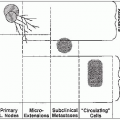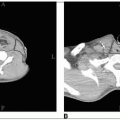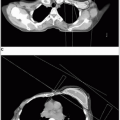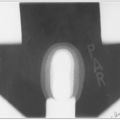Radiation Treatment of Benign Disease
Though radiation oncologists are primarily involved in the care of malignant tumors, radiation therapy also plays a role in many benign diseases. The inherent risks of late skin injury, carcino genesis, leukemogenesis, and genetic damage must be carefully considered before treating any patient with ionizing radiation. However, radiation oncologists are ideally suited to treat even those patients with benign disease, as they have great proficiency in utilizing all clinical and technical aspects of ionizing radiation. A survey by Order and Donaldson assessed almost 100 indications of radiation therapy for benign diseases and found that only 10 indications are actually treated by greater than 90% of American radiation oncologists. Furthermore, only 30 radiation oncologists of those surveyed treated 30 or greater indications (42).
TECHNICAL CONSIDERATIONS
The report of the Committee on Radiation Treatment of Benign Disease of the Bureau of Radiological Health recommends the following:
Before institution of therapy, the quality of the radiation, total dose, overall treatment time, underlying organs at risk, and shielding factors should be considered.
Infants and children should be treated with ionizing radiation only in very exceptional cases and only after careful evaluation of the potential risks compared with the expected benefit.
Direct irradiation of regions overlying organs, which are particularly prone to late effects such as the thyroid, eye, gonads, bone marrow, and breast, should be avoided.
Meticulous radiation protection techniques, including cones and lead shields, should be employed in all instances.
The depth of penetration of the x-ray beam should be chosen in accordance with the depth of the pathologic process.
Kopicky and Order (31) analyzed the current use of radiation therapy for benign disease by radiation oncologists. On the basis of replies from those surveyed, 70 diseases mentioned in the questionnaire were divided into the categories of “acceptable for treatment” and “unacceptable for treatment” (at most centers).
RADIATION THERAPY TECHNIQUES
There are wide differences of opinion among radiation oncologists about the optimal dose and fractionation for treatment of most diseases.
The choice of beam energy depends on the depth of the target volume, and every effort should be made to spare underlying normal tissue in superficial lesions.
The appropriate energy depends on the type of modality used: electrons, low-energy x-rays, or high energy photons.
Lead shields should be used not only to define the field but also to protect underlying cavities from radiation.
EYE
Pterygium
It consists of fibrovascular proliferative tissue, which most commonly originates from the medial bulbar conjunctiva and extends onto the cornea.
Symptoms include tearing, foreign body sensation, and visual impairment.
Treatment is indicated if there is encroachment of the pupil or if the patient is symptomatic.
The treatment of choice for pterygium is surgery; however, the recurrence rate is 20% to 30% with this modality alone (11).
Radiation is typically indicated after relapse or adjuvantly after local resection of a pterygium, though a few centers have used primary or preoperative radiation therapy.
Van den Brenk (57) reported a recurrence rate of only 1.4% in 1,300 pterygia in 1,064 patients treated with prophylactic postoperative beta-ray therapy with a 90Sr applicator. Treatment consisted of 8 to 10 Gy given for each of three applications on days 0,7, and 14 after the operation. Comparable results with similar radiation doses have been reported by others (8, 43, 59).
In a randomized controlled trial of 25 Gy in 1 fraction of beta radiation versus sham radiation, there was a significantly lower relapse rate with postoperative radiation, 93% versus 33%. Furthermore, at a mean follow-up of 18 months, there were no major treatment complications observed (27).
Thyroid Ophthalmopathy
The pathogenesis is believed to be an autoimmune reaction directed toward orbital fibroblasts in which activated T lymphocytes invade the orbit. This stimulates glycosaminoglycan production by fibroblasts, resulting in a hyperosmotic shift causing tissue edema and marked enlargement of the extraocular muscles.
Signs and symptoms of Graves’ophthalmopathy include bilateral exophthalmos, extraocular muscle dysfunction, diplopia, blurred vision, eyelid and periorbital edema, chemosis, lid lag, and compressive optic neuropathy. The clinical signs are grouped according to the NOSPECS system, which classifies six disease categories and three degrees of severity; the sum of the parameters constitutes the ophthalmopathy index.
Historically, corticosteroids have been used as the first line of therapy for patients with Graves’ ophthalmopathy, whereas surgical decompression has typically been reserved for patients with advanced disease or those who failed first-line therapy. There is a meta-analysis that shows that corticosteroid therapy improves symptoms in 65% of patients. However, proptosis often persists and many patients relapse following corticosteroid taper, eventually requiring surgical intervention or orbital radiation therapy (46).
As lymphocytes and fibroblasts are quite sensitive to radiation, retrobulbar irradiation is a logical method of treatment. Radiation is most effective for soft tissue symptoms such as redness, edema, and chemosis.
In 311 patients treated with orbital irradiation, 80% showed improvement or complete resolution of soft tissue symptoms (44). A significant response was demonstrated in more than 75% of the patients with corneal manifestations such as stippling and ulceration. Extraocular dysfunction and proptosis were improved in 61% and 52% of patients, respectively. Defects in visual acuity responded in 41% to 71% of patients. After irradiation, corticosteroid therapy was successfully discontinued in 76% of patients. Corrective or cosmetic eye surgery was necessary in only 29% after radiation therapy, and in most instances, it was done to correct diplopia.
Marquez et al. (36) have recorded 453 patients receiving retrobulbar radiation therapy for Graves’ophthalmopathy One hundred ninety-seven had more than 1 year of follow-up.
There was an improvement or resolution in the size of soft tissue findings in 89% of patients. Additionally, patients had improvements in proptosis (70%), extraocular muscle dysfunction (85%), corneal abnormalities (96%), and vision (67%).
Prummel et al. (45) conducted a randomized study comparing prednisone and retrobulbar radiation, which showed equal outcomes, approximately 50%, for both treatments. However, there was a much higher rate of minor, moderate, and major complications with prednisone.
In another randomized trial, the addition of radiation showed no significant symptomatic benefit for thyroid opthalmopathy categories I through III, but substantial benefit for advanced thyroid opthalmopathy, categories IV and V. The authors concluded that radiation is best utilized for thyroid categories IV through VI, orbitopathy index of greater than 4, and in those patients with nonrecurrent symptoms of grades 2 and 3 (40).
Megavoltage external-beam irradiation using precise planning with high-resolution computed tomography (CT), along with complete patient immobilization, is required for optimization of the dose distribution and to avoid unwanted irradiation of sensitive structures, such as the lens and pituitary gland.
Small opposed bilateral fields are used to encompass both retrobulbar volumes with customized blocks to shield periorbital structures.
Either a split-beam technique or a 5-degree posterior angulation should be used to avoid irradiating the lens.
A total dose of 20 Gy to the midplane given in 10 fractions over a 2-week period is recommended; doses greater than 20 Gy do not improve the outcome.
Photons in the range of 6 to 10 MV are used.
Special care should be exercised in the selection of beams and calculation of doses to avoid excessive dose to the optic nerve and other sensitive ocular structures.
Special attention should be paid to the total dose administered to the midline structures when concurrent opposing lateral portals are used; the dose contribution from each portal should be taken into account.
Radiation therapy produces an effective and safe treatment for progressive Graves’ ophthalmopathy, with a 96% overall response rate, 98% patient satisfaction rate, and no irreparable long-term sequelae with follow-ups extending 20 years or more.The most common late effect observed is the development of cataracts, which occurs more frequently in older patients and is reversible with extraction. Overall, if appropriately indicated and precisely administered, radiation therapy for advanced thyroid opthalmopathy offers a favorable risk-benefit ratio.
Orbital Pseudotumor
Lymphoid diseases of the orbit represent a spectrum of diseases and are classified into three groups: pseudolymphoma (which includes orbital pseudotumor and reactive hyperplasia), atypical lymphoid hyperplasia, and malignant lymphoma.
Orbital pseudotumor is a benign, idiopathic orbital inflammation that can simulate Graves’ exophthalmos or tumor. Though the etiology is unclear, three possible causative mechanisms have been postulated: an infectious process, an autoimmune process (circulating antibodies against extraocular muscle proteins), or a fibroproliferative process.
Typically, unilateral orbital involvement with acute onset of retrobulbar pain, exophthalmos, and impaired eye motility are seen, though bilateral involvement can be present in up to 50% of patients.
There may be a palpable mass or proptosis with progressive loss of vision.
CT or MRI is helpful in differentiating pseudotumor from Graves’ disease, if the retro-orbital muscles are primarily involved, but biopsy is usually required to define the disease process.
Corticosteroids are the primary therapy, but up to 50% of patients have an insufficient response or have to discontinue steroids secondary to untoward effects. If the disease is not appropriately treated, it can lead to progression with subsequent permanent deterioration of visual acuity.
A 4- to 6-MV photon beam is used with unilateral or bilateral temporal fields posterior to the lens, or with a split-beam technique for better lens protection.
The most commonly utilized dose is 20 Gy in 10 fractions over a 2-week period.
Patients should be monitored closely because subsequent progression to systemic lymphoma has been reported in up to 29% of patients (3).
Macular Degeneration
Age-related macular degeneration is the leading cause of severe blindness in the United States today.
The incidence increases with age, with the disease afflicting 11% of patients between 65 and 74 years of age and 28% of patients older than 75 years of age (9).
The neovascular (wet) type occurs when choroidal vessels penetrate Bruch’s membrane and proliferate beneath the retinal pigment epithelium, leading to choroidal neovascularization, subretinal hemorrhage, and serous retinal detachment.
Approximately 10% of patients with age-related macular degeneration develop the wet form, which accounts for the majority of those who become legally blind.
When the choroidal neovascular membrane is subfoveal, the visual prognosis is poor, with severe vision loss in more than 75% of patients at 2 years (24).
In the past, treatments with laser coagulation or photodynamic therapy were the primary methods of managing wet macular degeneration; however, these modalities frequently lead to unsatisfactory outcomes. The emergence of antivascular endothelial growth factor receptor agents such as ranibizumab, given as intraocular injections into the vitreous cavity, has revolutionized the management of this disease entity. These agents are the mainstay of current therapy for choroidal neovascularization, regardless of the location in the macula (10, 47).
In one randomized trial, visual acuity improved by 15 or more letters in 33.8% of the patients receiving 0.5-mg intravitreal injections of ranibizumab, as compared with 5.0% of the sham-injection group (47).
Brachytherapy, photons, and protons have all been utilized for treatment; however, no comparative studies have been performed.
The rationale for using local irradiation for choroidal neovascular membrane is based on the radiosensitivity of proliferating endothelial cells, reduction in the inflammatory response, and possible occlusion of aberrant vessels.
Chakravarthy et al. (13) reported results in 19 patients with subfoveal neovascular membranes due to age-related macular degeneration treated with 10 Gy at 2 Gy per fraction or 15 Gy at 3 Gy per fraction. Using patients who declined treatments as controls, the data indicated that at 12 months, visual acuity was maintained or improved in 63% of patients and significant neovascular regression was recorded in 77% of treated patients. Visual acuity deteriorated in six of seven controls, and all showed progressive enlargement of membranes. There was no significant difference in outcome between the two dose regimens.
In an update from the same institution, significant improvement in visual acuity and reduced subretinal scarring were reported in 35 treated eyes, compared with the untreated eyes in the same patients (25).
Bergink et al. (5) reported their findings of comparing four different dose regimens. The best results were seen with 12 Gy in 2 fractions, 18 Gy in 3 fractions, or 24 Gy in 4 fractions. Stable visual acuity was reported in 21 of 30 patients treated.
Freire et al. (18) reported on 41 patients treated with 14.4 Gy in 8 fractions of 1.8 Gy each. CT-simulation treatment planning was performed using a unilateral oblique 6-MV photon field, half-beam blocked anteriorly to spare the ipsilateral lens and contralateral globe. Preliminary results at 2 to 3 months after treatment showed subjective visual acuity to be stable in 66%, improved in 27%, and worse in 7%.
Alberti et al. (1) published the results of various investigations into the treatment of wet macular degeneration. There was a significant positive impact seen in a large number of patients.
CENTRAL NERVOUS SYSTEM
Arteriovenous Malformations
Congenital disorder of abnormal vasculature forms a shunt between the high pressure arterial system and low pressure venous system, bypassing the capillary bed. Arteriovenous malformations (AVMs) are usually fragile and therefore are predisposed to bleeding, carrying with it significant morbidity and mortality.
Surgery, utilizing microsurgical techniques, is often the first-line treatment for AVMs as obliteration of the lesion from radiation can take up to 3 years. However, AVMs in deep or eloquent regions of the brain are often treated with stereotactic radiosurgery.
AVMs of the brain are treated with stereotactic radiosurgery using a single fraction of high-dose radiation to a stereotactically defined small volume to sclerose the AVM and prevent hemorrhage.
Minimum doses of 15 to 30 Gy are prescribed in the periphery of the target; complete obliteration of the AVM is seen in 71% to 89% of patients within 2 years (50).
In a series by Maruyama, 500 patients were treated with stereotactic radiosurgery and followed with serial exams, MRI, and/or angiography. The mean dose delivered was 21 Gy, and the cumulative obliteration rate was 81% and 91% at 4 and 5 years, respectively. The hemorrhage risk was reduced by 54% during the latency period, and by 88% once there was complete obliteration (37).
Effective obliteration of the AVM after stereotactic radiosurgery correlates with the minimum dose delivered, but not with the maximum dose or volume treated (17).
Stereotactic radiosurgery is more effective when the AVM is less than 2 cm and when all feeder vessels are irradiated.
Stereotactic radiotherapy with 2 to 3 sessions of 8 to 10 Gy is equally effective.
Stay updated, free articles. Join our Telegram channel

Full access? Get Clinical Tree








